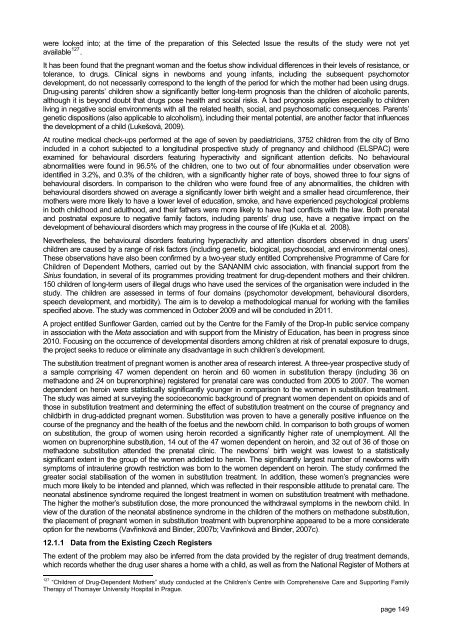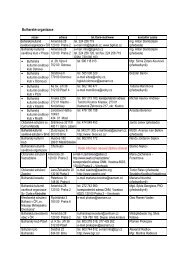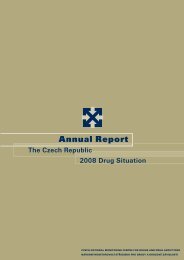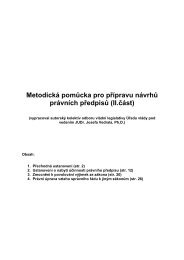The Czech Republic Annual Report 2010 Drug ... - Drogy-info.cz
The Czech Republic Annual Report 2010 Drug ... - Drogy-info.cz
The Czech Republic Annual Report 2010 Drug ... - Drogy-info.cz
You also want an ePaper? Increase the reach of your titles
YUMPU automatically turns print PDFs into web optimized ePapers that Google loves.
were looked into; at the time of the preparation of this Selected Issue the results of the study were not yet<br />
available 127 .<br />
It has been found that the pregnant woman and the foetus show individual differences in their levels of resistance, or<br />
tolerance, to drugs. Clinical signs in newborns and young infants, including the subsequent psychomotor<br />
development, do not necessarily correspond to the length of the period for which the mother had been using drugs.<br />
<strong>Drug</strong>-using parents’ children show a significantly better long-term prognosis than the children of alcoholic parents,<br />
although it is beyond doubt that drugs pose health and social risks. A bad prognosis applies especially to children<br />
living in negative social environments with all the related health, social, and psychosomatic consequences. Parents’<br />
genetic dispositions (also applicable to alcoholism), including their mental potential, are another factor that influences<br />
the development of a child (Lukešová, 2009).<br />
At routine medical check-ups performed at the age of seven by paediatricians, 3752 children from the city of Brno<br />
included in a cohort subjected to a longitudinal prospective study of pregnancy and childhood (ELSPAC) were<br />
examined for behavioural disorders featuring hyperactivity and significant attention deficits. No behavioural<br />
abnormalities were found in 96.5% of the children, one to two out of four abnormalities under observation were<br />
identified in 3.2%, and 0.3% of the children, with a significantly higher rate of boys, showed three to four signs of<br />
behavioural disorders. In comparison to the children who were found free of any abnormalities, the children with<br />
behavioural disorders showed on average a significantly lower birth weight and a smaller head circumference, their<br />
mothers were more likely to have a lower level of education, smoke, and have experienced psychological problems<br />
in both childhood and adulthood, and their fathers were more likely to have had conflicts with the law. Both prenatal<br />
and postnatal exposure to negative family factors, including parents’ drug use, have a negative impact on the<br />
development of behavioural disorders which may progress in the course of life (Kukla et al. 2008).<br />
Nevertheless, the behavioural disorders featuring hyperactivity and attention disorders observed in drug users’<br />
children are caused by a range of risk factors (including genetic, biological, psychosocial, and environmental ones).<br />
<strong>The</strong>se observations have also been confirmed by a two-year study entitled Comprehensive Programme of Care for<br />
Children of Dependent Mothers, carried out by the SANANIM civic association, with financial support from the<br />
Sirius foundation, in several of its programmes providing treatment for drug-dependent mothers and their children.<br />
150 children of long-term users of illegal drugs who have used the services of the organisation were included in the<br />
study. <strong>The</strong> children are assessed in terms of four domains (psychomotor development, behavioural disorders,<br />
speech development, and morbidity). <strong>The</strong> aim is to develop a methodological manual for working with the families<br />
specified above. <strong>The</strong> study was commenced in October 2009 and will be concluded in 2011.<br />
A project entitled Sunflower Garden, carried out by the Centre for the Family of the Drop-In public service company<br />
in association with the Meta association and with support from the Ministry of Education, has been in progress since<br />
<strong>2010</strong>. Focusing on the occurrence of developmental disorders among children at risk of prenatal exposure to drugs,<br />
the project seeks to reduce or eliminate any disadvantage in such children’s development.<br />
<strong>The</strong> substitution treatment of pregnant women is another area of research interest. A three-year prospective study of<br />
a sample comprising 47 women dependent on heroin and 60 women in substitution therapy (including 36 on<br />
methadone and 24 on buprenorphine) registered for prenatal care was conducted from 2005 to 2007. <strong>The</strong> women<br />
dependent on heroin were statistically significantly younger in comparison to the women in substitution treatment.<br />
<strong>The</strong> study was aimed at surveying the socioeconomic background of pregnant women dependent on opioids and of<br />
those in substitution treatment and determining the effect of substitution treatment on the course of pregnancy and<br />
childbirth in drug-addicted pregnant women. Substitution was proven to have a generally positive influence on the<br />
course of the pregnancy and the health of the foetus and the newborn child. In comparison to both groups of women<br />
on substitution, the group of women using heroin recorded a significantly higher rate of unemployment. All the<br />
women on buprenorphine substitution, 14 out of the 47 women dependent on heroin, and 32 out of 36 of those on<br />
methadone substitution attended the prenatal clinic. <strong>The</strong> newborns’ birth weight was lowest to a statistically<br />
significant extent in the group of the women addicted to heroin. <strong>The</strong> significantly largest number of newborns with<br />
symptoms of intrauterine growth restriction was born to the women dependent on heroin. <strong>The</strong> study confirmed the<br />
greater social stabilisation of the women in substitution treatment. In addition, these women’s pregnancies were<br />
much more likely to be intended and planned, which was reflected in their responsible attitude to prenatal care. <strong>The</strong><br />
neonatal abstinence syndrome required the longest treatment in women on substitution treatment with methadone.<br />
<strong>The</strong> higher the mother’s substitution dose, the more pronounced the withdrawal symptoms in the newborn child. In<br />
view of the duration of the neonatal abstinence syndrome in the children of the mothers on methadone substitution,<br />
the placement of pregnant women in substitution treatment with buprenorphine appeared to be a more considerate<br />
option for the newborns (Vavřinková and Binder, 2007b; Vavřinková and Binder, 2007c).<br />
12.1.1 Data from the Existing <strong>Czech</strong> Registers<br />
<strong>The</strong> extent of the problem may also be inferred from the data provided by the register of drug treatment demands,<br />
which records whether the drug user shares a home with a child, as well as from the National Register of Mothers at<br />
127<br />
“Children of <strong>Drug</strong>-Dependent Mothers” study conducted at the Children’s Centre with Comprehensive Care and Supporting Family<br />
<strong>The</strong>rapy of Thomayer University Hospital in Prague.<br />
page 149

















